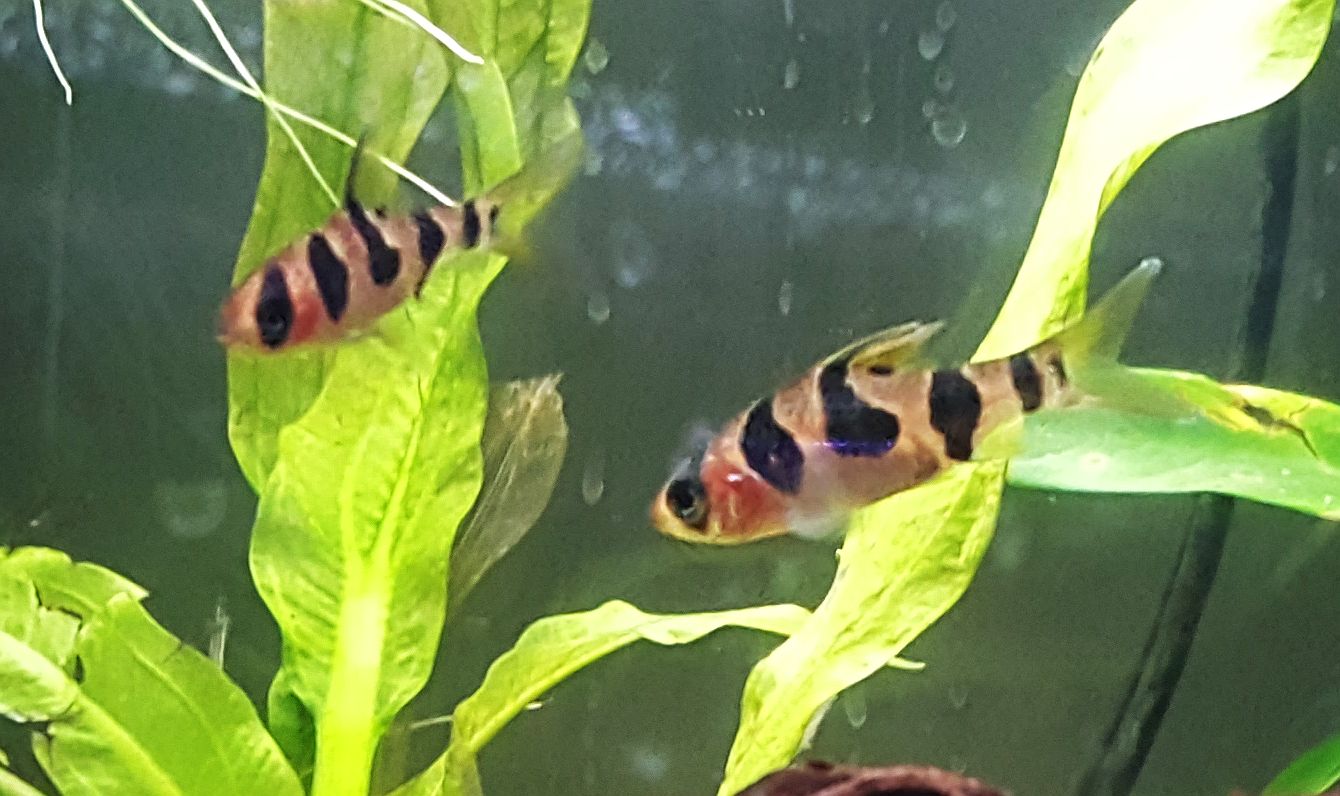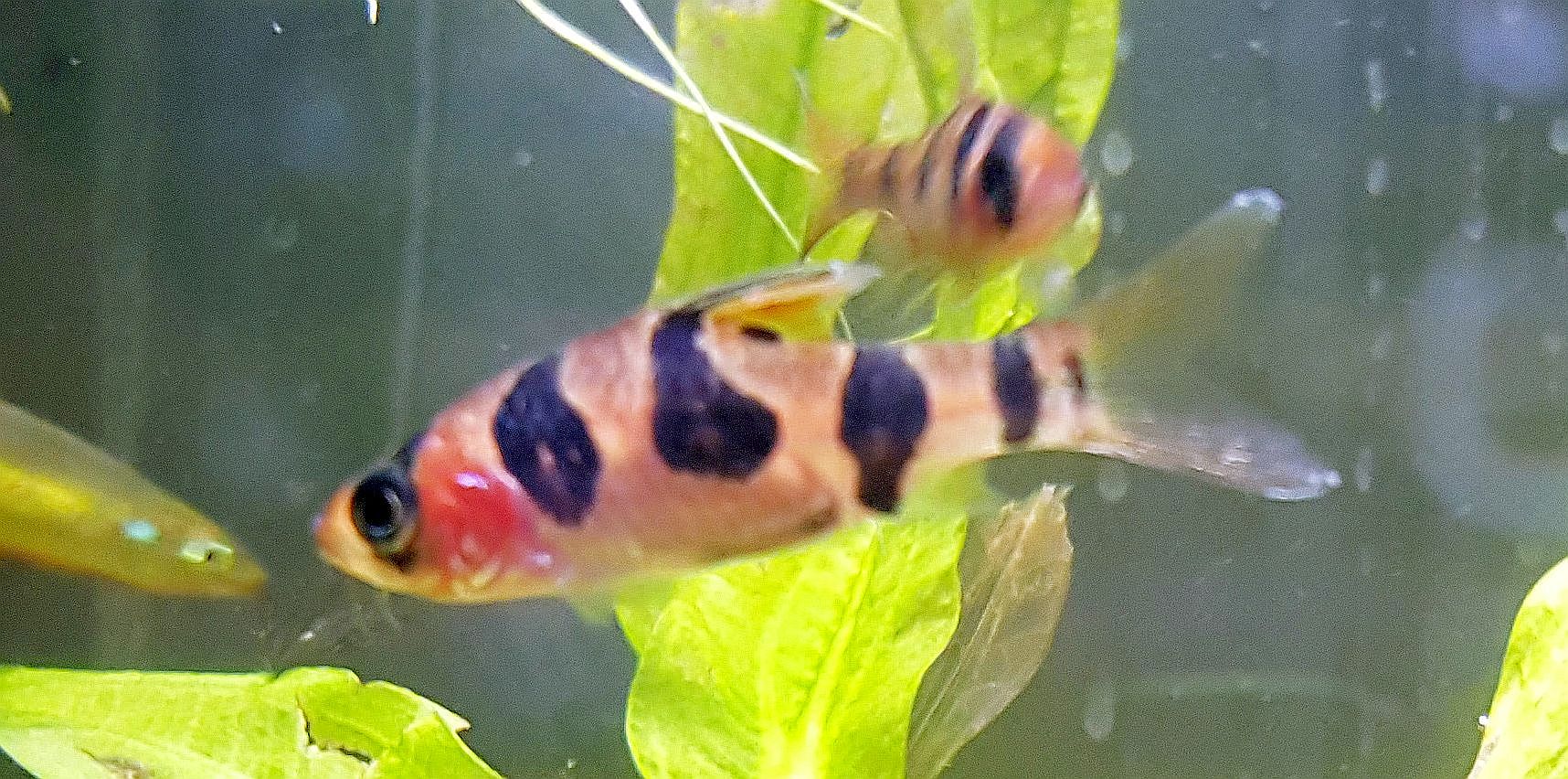The Rhombo Barb (Desmopuntius rhomboocellatus) known to tropical fish keeping enthusiasts as the Snakeskin Barb, Red Ocellated Barb, or Rhomb Barb is native to West and Central Kalimantan in Borneo, Indonesia.
Rhombo Barbs are a peaceful schooling species that thrive in the tannin stained backwaters of their range. They are typically collected in still water peat swamps with lots of dense riparian vegetation and submerged grass or aquatic plants where they feed on small insects, crustaceans, worms, and other zooplankton.
The waters that Desmopuntius rhomboocellatus are found in are normally littered with fallen leaves, submerged roots, tree branches, and decaying organic matter which causes the pH to be as low as 3.0 with a negligible dissolved mineral content.
The Rhombo Barb has an orange/red body color with five deep black to dark green body splotches that give the fish it’s “snakeskin” moniker.
The relatively small eyes are located within the first body splotch and except for the dorsal fin, which has a dark black and yellow leading edge, the pectoral, anal, and caudal fins are clear.
Adult males are slightly smaller, noticeably slimmer, and more intensely colored than females. Females are somewhat broader and fuller bodied than males, especially when gravid.
The Rhombo Barb is best kept in schools of at least 6 or more specimens in an aquarium environment. Because they are more peaceful than most barbs, they can be housed in a community aquarium with other peaceful, short finned species of the same size. Cyprinids, cobitids, and several anabantoids from the same area would be good choices for tank mates.
Some of the more commonly available species available to tropical fish keeping enthusiasts from Borneo include Desmopuntius johorensis, Desmopuntius hexazona, Brevibora dorsiocellata, Trigonopoma pauciperforatum, Rasbora einthovenii, and various Pangio spp.
Rhombo Barbs are best housed in a densely planted, dimly lit aquarium of at least 29 gallon capacity, with a fine gravel or sand substrate, some driftwood or bogwood roots, some Indian Almond Leaves
or other leaf litter, and some floating plants
to diffuse any overhead lighting. They require plenty of free swimming space and spotlessly clean, soft, acidic water to prevent disease. A bio-wheel
or outside hanging type peat filtration system is recommended for minimum water movement.
Successful breeding of the Rhombo Barb requires strict adherence to water softness and acidity, which is why there have been no reports of them being bred in an aquarium environment. However, like most small cyprinids, they are egg scattering free spawners that exhibit no parental care for the eggs or fry.
In a mature, densely planted, dimly lit aquarium, well conditioned Desmopuntius spp. will spawn frequently and in many cases small numbers of fry will magically appear from the plants.
For maximum yield, it’s best to condition a small group of adults with live or frozen daphnia, bloodworms, or brine shrimp and place them in a dimly lit tank filled with aged water and a plastic grass type matting or a layer of large marbles covering the bottom. The idea is to have the eggs fall through the substrate so the parents can’t get to the eggs.
The water quality should be slightly acidic with a temperature close to 80° F. An air powered corner sponge filter should be provided for oxygenation and some water movement along with an aged bag of peat to maintain optimum water chemistry.
When the females look gravid, place one or two of the well conditioned pairs into the breeding tank and spawning should take place the next morning.
If all goes well and the adults do not eat the eggs as they fall, the remaining eggs should hatch out in 24 to 36 hours. Remove the adults from the tank as soon as eggs are laid to maximize the yield. The fry are normally free swimming after 3 or 4 days and can be fed infusoria or equivalent foods until they are large enough to consume baby brine shrimp, microworms, etc.
Although Rhombo Barbs are considered omnivorous, they do best on a varied diet of live, frozen, or freeze dried brine shrimp, bloodworms, tubifex, mosquito larvae, daphnia, and a quality flake or micro pellet food.
Although they are not considered “rare”, the Rhombo Barb (Desmopuntius rhomboocellatus) is not a common item in most tropical fish keeping shops. They are available online from a variety of sources and are sold at a purchase size of 1″ to 1-3/4″.
Minimum Tank Size: 29 gallons
Care Level: Moderate
Temperament: Peaceful
Aquarium Hardiness: Hardy
Water Conditions: 73-82° F, KH 4-10, pH 5.5-7.0
Max. Size: 2″
Color Form: Orange
Diet: Omnivore
Compatibility: Community tank
Origin: Borneo, Indonesia
Family: Cyprinidae
Lifespan: 4-6 years
Aquarist Experience Level: Beginner/Intermediate




